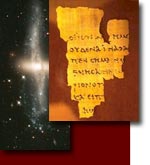| Site Map | Contacts | Links | Newsletter | |
Genesis 1:14-19 DAY 4
The Morning Star
In the ANE the "morning star" was the planet Venus that rose before dawn to herald a new day. In Summer the morning star and the evening star were different names and gods even though it was the same planet Venus.
The Canaanites identified Astarte (Evening Star) and Asheroth (Morning Star) with the planet Venus (COS, 281 n.51). In the Old Testament Venus is called the "Queen of Heaven." Jeremiah 44:17 says, "We will burn incense to the Queen of Heaven and will pour out drink offerings to her just as we and our fathers, our kings and our officials did in the towns of Judah and in the streets of Jerusalem" (NIV). During the time of Manasseh they thought their prosperity was a result of their worship to the Queen of Heaven.
Venus Tablet of Ammizaduga
In the British Museum there are a series of 70 Babylonian tablets of which number 63 is devoted exclusively to the planet Venus. In one place it refers to the "Year of the Golden Throne" which scholars identify with the reign of Ammizaduga who was ruler in the first Hittite dynasty of Babylon in the 17th century BC. The tablet tells which day of the month Venus appears and disappears. This is a key text in solving chronology problems. There has been much debate, but most think 1581 BC is the starting date of this tablet (Aveni, 1992, 119). A recent article in Sky & Telescope entitled Astronomy and the Fall of Babylon by Vahe G. Gurzadyan posits a date 96 years younger putting the fall of Babylon at 1499 BC. (July, 2000, 40-45).
Descent of Inanna
Inanna is a Sumerian goddess associated with the planet Venus. Inanna is called Ishtar by the Babylonians. This story parallels what the planet Venus does in the sky. There are seven gates that Inanna must pass through to go down to the underworld which probably are the five wandering planets plus the sun and moon. Venus becomes paler and paler as it descends in the night sky getting closer and closer to the horizon. Then Venus disappears below the horizon or into the underworld for three days and three nights. Then Venus rises in the morning above the horizon from the underworld which usually happens in February. Venus climbs higher and higher in the sky, but just can not make it up as high as the other planets, and circumpolar stars. Then Venus begins its descent back down to the horizon (Aveni 1992, 57-58; Jacobsen 1976, 138-9).
The Sumerian text of Inanna’s Descent to the Nether World says, "The sick 'women' was turned into a corpse, The corpse was hung from a stake. After three days and three nights" (ANET, 55; Wolkstein and Kramer 1983, 61; Kramer 1963, 153).
In Isaiah 14 Lucifer (Daystar), son of the morning, seems to be this same story of Venus’ rise and fall in the heavens. Lucifer tries to reach to the highest heaven, but can not, and falls down into the underworld.
Jesus is called "the bright and morning star" for just as Venus is three days and three nights below the horizon in the underworld then arises up, so too does Jesus.
Revelation 22:16 says, "I, Jesus have sent my angel to give you this testimony for the churches. I am the Root and the Offspring of David, and the bright Morning Star" (NIV).
Next - Star of Bethlehem
Bibliography
